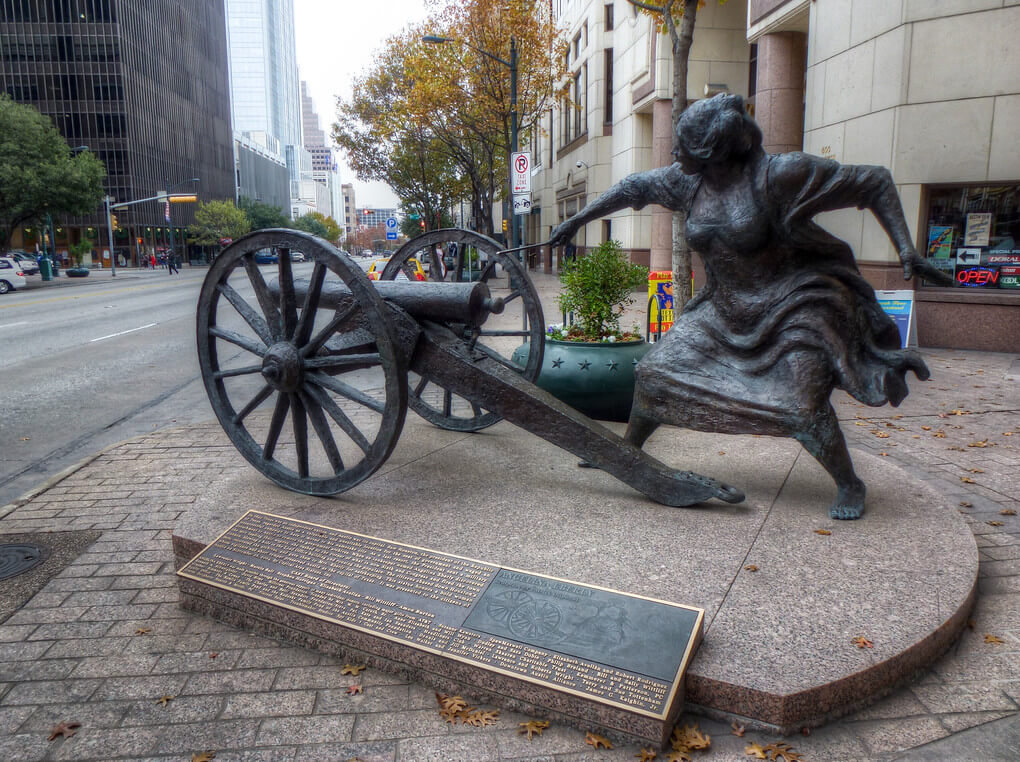The Historic Round Rock Collection
The Archives War
The Historic Round Rock Collection is a project documenting Round Rock’s history, funded in part with a grant from the Texas Historical Commission. These pages are adapted from the original 1991 print version.
As the Pioneers were returning to Texas, another event in the Republic’s history was unfolding. While the Santa Fé Expedition began at Kenney Fort, the Archives War would end there.

During the Lamar administration, the capital of the Republic of Texas was moved to Austin. The next president, Sam Houston, considered Austin “the most unfortunate site on earth for a Seat of Government” (Quoted in Connor et al. 91). He wanted to return the capital to Houston and in March of 1842 he was given a reason. A Mexican army, between 800 and 1400 strong, took San Antonio, asserted Mexican sovereignty over all of Texas, and retreated (Ibid. 92). Austin was only eighty miles from San Antonio, and even “more exposed”, Houston said, to enemy attack (Houston 2:529).
Houston called the legislature into session in Houston and on March 10 ordered all government officials to relocate there from Austin. On March 10, Houston ordered all the government department heads to transfer their records to Houston. He added, “If all cannot be brought off, by all means secure the land papers and the Auditor’s and Comptroller’s” (Ibid. 495). The Austin citizenry opposed this action and George Hockley, the Secretary of War, decided not to move the archives because of the threat of violence. Sam Houston expressed annoyance at the delay: “I suppose they think, that if the archives were actually destroyed, it would then be a proper time for their removal” (Ibid. 529). He reiterated his order but wanted to avoid unrest in Austin. He wrote to George Hockley:
“[The] time has come; and if [the citizens of Austin] should offer any violence to their removal, you will have them safely deposited in some house, and have a confidential man left in charge of them….If the people of Austin are really in good earnest to keep the archives safe, as they aver; and you cannot bring them without violence, and should deem it wise and prudent to leave them, then the people can protect them (Ibid.).”
On March 16 and 17 the citizens of Austin and Travis County held a meeting to discuss the transfer order. The meeting concluded by urging Houston “to countermand the order and permit the archives to remain at the present seat of government” (Ibid. 532). Houston responded by thanking the citizens for their offer to protect the archives but reminded them that he was constitutionally empowered to move the seat of government in case of emergency (Ibid. 533).
The citizens of Austin continued to resist, fearing that if the archives were moved their city would never again be the capital of the Republic (Connor et al. 92). In July, the crisis worsened. Adrian Woll, a Mexican general, retook San Antonio and prepared to stay. Quickly organized volunteers forced the army to retreat but the vulnerability of San Antonio, and by extension Austin, made Houston even more anxious to move the records (Ibid. 93).
He continued to insist that the records be transferred from Austin, now to Washington-on-the-Brazos.1 On September 28, Colonel Thomas Ward closed the Land Office and tried to move the archives east. However, no one in Austin was willing to provide transportation and the attempt failed (Scarbrough 102).
Finally, in early December, Sam Houston wrote to two trusted men, Thomas Smith and Eli Chandler, and ordered them to travel to Austin and transfer the records. In the letter, Houston explained his reasons for wanting the archives out of Austin:
“The importance of removing the public archives and government stores from their present dangerous situation at the City of Austin to a place of security, is becoming daily more imperative. While they remain where they are, no one knows the hour when they may not be utterly destroyed. They are constantly liable to attack and destruction by the enemy.” (Houston 3: 226.)
Houston knew this action would be unpopular in Austin and warned his agents:
“[C]onduct your operations with the utmost secrecy; and by all means raise a sufficient force to take possession of and guard the archives, before any rumor of your intended visit could possibly be received there. You might raise your men as for an Indian excursion; and by no means let your object be known till you are ready to act. Threats have been made, that if the archives are ever removed, they will be in ashes. The loss to the country in such an event would be infinite and irreparable.” (Ibid. 227)
Chandler and Smith and eighteen other men began loading the archives onto three wagons at noon on December 30, 1842 (Ibid. 230). The wagons headed north towards Kenney Fort, stopping there to spend the night inside the stockade. Some twenty or thirty angry Austin residents followed behind, dragging their cannon with them. The next morning, the Austinites demanded at cannon-point that the records be returned. Thomas Smith, outgunned and surrounded, surrendered the archives without a fight. Thus the Archives War ended. The stubbornness of the Austinites had thwarted the will of Sam Houston.
Commissioner Thomas Ward, of the Land Office, described the event as follows:
“Much excitement prevailed here; a Howitzer loaded with grape2 was discharged at my residence after I heard the cry of ‘blow the old house to pieces;” eight shots perforated the building, and had the mob have continued their fire, I could not have answered for the consequences, as I undoubtedly should have defended myself to the last; the wagons took the upper route by Kinneys because of the people living on Brushy not being so violent against the removal as those living below, or on the road to Bastrop, and to prevent violence to the papers, etc., I sent two of the Land Office clerks in charge of them with positive instructions to take special care of the boxes and their contents and not to interfere with the people in case of their rioting with the wagon guard, but to keep an eye single to their charge and not on any account to give them up to any person which I must regret to inform you they could not do.” (Ibid. 230)
Unfortunately, no first-hand accounts of the events at Kenney Fort have been found. W. K. Makemson, in his early history of Williamson County, wrote sixty years later about this “very interesting historical incident” (“Some Early…” 79):
“[T]he men with wagons containing the books and papers reached the Fort late in the evening, and obtained permission from Dr. Kenney to camp inside the stockade, which enclosed a court of considerable size. That night a company of men from Austin, commanded by Capt. Mark D. Lewis, reached the Fort, and the following morning, Dec. 31, 1842, compelled the parties in charge of the wagons to return to Austin with the archives.” (Ibid.)

It has been suggested that Houston wanted the archives and the capital moved more out of a personal dislike of Austin than because of any real danger (Scarbrough 102). However, Austin was not well-protected and many Austinites knew it. One account states that “90 percent” of the town’s population left within twenty-four hours of the hearing that San Antonio had been captured by a Mexican army. Fewer than half returned (Conner et al. 93). The threat of Indian attack was also ever-present. Five Austinites were attacked just two miles from the city in September and Land Office Commissioner Ward reported an attack in January of 1843. Sam Houston was apparently well-justified in his belief that Austin was not safe. The residents of Austin were also correct in believing that if the records were moved, the city would begin to die. Austin won the war because its residents were more tenacious than Sam Houston.
Notes
1 Sam Houston found the City of Houston unsatisfactory as a seat of government and reconvened the legislature at Washington-on-the-Brazos. Except for the housing of the government records, all government activities were carried out in Washington. Effectively, Austin was no longer the capital of Texas. return to text
2 Grape refers to small iron balls that could be fired from a cannon. return to text
Works Cited
Connor, Seymour V., et al. Capitols of Texas. Texian Press, Waco, Texas: 1970.
Houston, Sam. Writings of Sam Houston. 8 Vols. Amelia Williams and Eugene Barker (eds.). The University of Texas press, Austin, Texas. 1939.
Scarborough, Clara Stearns. 1973. Land of Good Water, Takachue Pouetsu: A Williamson County, Texas History. Williamson County Sun Publishers, Georgetown, Texas.
“Some Early Williamson County History” in Frontier Times. No date. Photocopy in Round Rock Public Library. Article reprinted from Williamson County Sun (Georgetown) April 7, 1936. Original W. K. Makemson. Historical Sketch of First Settlement and Organization of Williamson County. Sun Print, Georgetown, Texas. 1904


